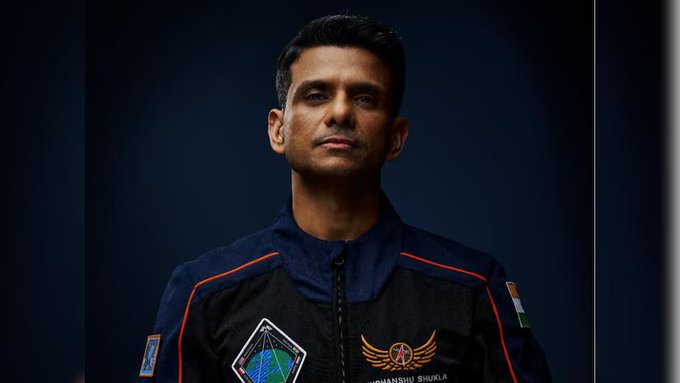
Shubhanshu Shukla’s Historic Spaceflight: On June 25, 2025, Group Captain Shubhanshu Shukla of the Indian Air Force made his mark in the space as the second Indian astronaut to go to space and the first of any Indian to pilot a mission to the International Space Station (ISS). Liftoff from NASA’s Kennedy Space Center in Florida marked the beginning of the Crew Dragon’s journey as the SpaceX Falcon 9 rocket powered the capsule named Grace into orbit. The crewed mission serves as Axiom Space’s Axiom Mission 4 (Ax‑4), co-sponsored by NASA and carried out with the help of SpaceX.
Shubhanshu Shukla’s Historic Spaceflight
Launched by borrowing Launch Complex 39A—the same pad used by Neil Armstrong’s crew in 1969 Shukla launched on his mission at 12:01 PM IST (2:31 AM EDT). Just nine minutes after liftoff, the Falcon 9 booster completed a textbook return to Earth that exemplifies SpaceX’s reusable rocket technology. In his own words, from space:
“Namaskar mere deshvasiyo… what a ride! Hum 41 saal baad waapas antrishk mei pahunch gaye hain.”
—Shubhanshu Shukla
This powerful moment was felt throughout India, with live celebrations in Lucknow, messages of congratulations from PM Modi and President Murmu, and jubilant celebrations by the home state of the performers.
Mission Profile & Scientific Ambitions
The 14-day mission carries Shukla with commander Peggy Whitson (USA) and specialists from Poland and Hungary. He will spearhead seven India-specific microgravity studies, including a study on germination of seeds in space—a first for an Indian astronaut. The mission has inspired cultural outreach—sharing music, national symbols, and meals themed to each nation aboard ISS.
Unimech Aerospace IPO Listing: Can It Deliver Multibagger Returns?
India’s Return to Crewed Spaceflight
Shukla’s journey represents India’s first return to crewed missions since the 1984 Soyuz flight of Rakesh Sharma, who orbited with the Soviets 41 years ago. Unlike Shukla, who has become the first Indian to visit the ISS, Sharma went to the Salyut 7 space station. His flight is a big milestone to ISRO’s own Gaganyaan mission, with crewed launch targeted for Q1 2027.
Shubhanshu Shukla’s Historic Spaceflight: Global Market & Economic Impact
This mission marks another step on the continuing and accelerating path to a commercial LEO economy. Each ticket—which are said to be worth $65–70 million—involve extensive training, the launch itself, and a two-week stay on board ISS. This makes flying with Boeing or SpaceX an economically viable alternative to building your own independent space program.
With this flight, Axiom Space takes another step toward its mission of constructing the first private, orbiting space station with Axiom modules first docked to ISS, then operating on their own after 2030. This commercial shift is luring in a wave of venture capital and international investment, pointing to a rapidly expanding multi-trillion-dollar “space economy,” expected to soar to $1.8 trillion by 2035.
For SpaceX, missions like Ax‑4 solidify its emergence as the launch sector’s alpha company, taking home approximately 87% of global upmass so far in 2023 on the back of reusable Falcon boosters and Crew Dragon capsules. In terms of changing the overall space infrastructure funding paradigm, NASA’s support through the Commercial LEO Destinations (CLD) program funding multiple commercial station projects is huge.
For investors and markets, this is the signal that the industry is making the shift from government-led to public–private ecosystems, ranging from crewed missions, satellite services, in-space manufacturing, research, and tourism. Axiom struggled with capital constraints and razor-thin margins. It is still positioned to be an important player in future LEO operations.
What This Means Moving Forward?
Shukla’s mission increases Gaganyaan momentum, improves global cooperation, national pride soars.
Missions such as Ax‑4 show the growing commercial viability of orbital crewed flights and drive faster development of private stations.
The effects of deepening private investment and government‑industry collaboration have a potential to change global supply chains, innovation pipelines, and economic opportunities associated with LEO.
In short, Group Captain Shubhanshu Shukla’s path to journey onboard Crew Dragon has begun, and while such an eventuality would be a notable achievement either fully or partially the strategic cornerstone would be the emergence of a new period defined by the intersection of commercial spaceflight, national aspirations, and globally competitive industries. His ascent not only rewrites Indian space history. It’s a harbinger of the new space economy that promises to radically remake entire industries, geopolitics, and, indeed, the very human presence on this planet.

